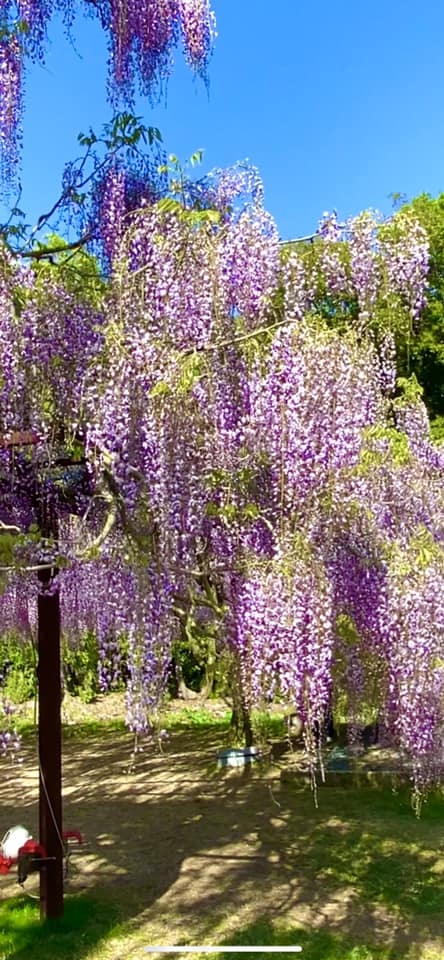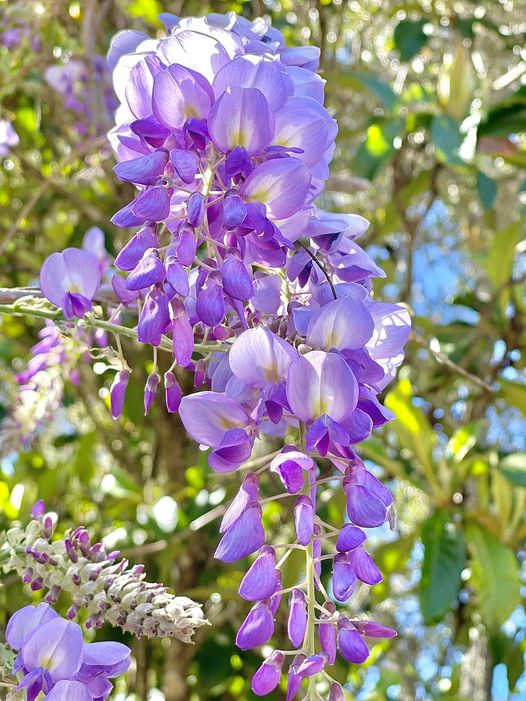
Wisteria, with its cascading curtains of fragrant blooms, is a sight that can stop you in your tracks. These vigorous climbers transform fences, pergolas, and even trees into breathtaking displays of color. But beneath their enchanting beauty lies a powerful will to grow. This guide will equip you with the knowledge to cultivate your own wisteria, ensuring it thrives and graces your landscape for years to come.
This post may have affiliate links. This means that sometimes when you click a link on our site and make a purchase on Amazon, we may earn a small commission at no additional cost to you. We only recommend products we truly believe in, and your support helps keep us running!
Choosing Your Wisteria Champion
There are two main types of wisteria commonly cultivated: Japanese wisteria (Wisteria floribunda) and Chinese wisteria (Wisteria sinensis). Both boast magnificent displays, but with slight differences:
Japanese wisteria

Renowned for its exceptionally long, drooping flower clusters in shades of lavender, white, or blue. It blooms later in spring, often after the leaves emerge. This variety is generally considered less vigorous than its Chinese counterpart.
Chinese wisteria

Flowers earlier in spring, with shorter, denser clusters in shades of violet, purple, or white. It tends to be more vigorous and grows faster than Japanese wisteria.
Beyond these two main types, consider these factors when selecting your wisteria:
- Bloom color: Do you have your heart set on a specific shade of purple, or perhaps a more whimsical white?
- Flowering time: If early spring blooms are your preference, Chinese wisteria might be the ideal choice.
- Available space: Both varieties are vigorous climbers, so ensure you have a sturdy support structure in place.
- Climate: Wisteria thrives in temperate climates with well-defined seasons. If you live in a particularly hot and humid region, Japanese wisteria might be better suited.
Pro Tip: For container growing, consider the dwarf varieties of Chinese wisteria, like ‘Blue Moon’ or ‘Miniature Black Dragon.’ These offer exceptional blooms in a more manageable size.
Planting Your Wisteria for Success
Location, Location, Location
Wisteria thrives in a sunny spot with at least 6-8 hours of direct sunlight daily. Avoid planting too close to your house, as its vigorous growth can damage siding and gutters. Leaving ample space between your wisteria and other plants is crucial, as it can easily outcompete them for nutrients and water.
Wisteria prefers well-draining soil with a slightly acidic to neutral pH (between 6.0 and 7.0). If your soil is heavy clay, amend it with compost or aged manure to improve drainage. A soil test can help determine the exact pH of your soil and if any amendments are necessary.
Planting Time
The ideal time to plant wisteria depends on your climate. In colder regions with harsh winters, plant in early spring when the soil warms. In warmer climates, fall planting allows the roots to establish before the summer heat arrives.
Planting Steps :
- Dig a hole at least twice the diameter of the root ball and just as deep.
- If amending the soil, mix the compost or manure with the excavated soil.
- Gently remove the wisteria from its container and loosen any tightly bound roots.
- Place the wisteria in the hole, ensuring the root crown sits slightly above the soil level.
- Backfill the hole with the amended soil, tamping gently to remove air pockets.
- Water thoroughly to settle the soil around the roots.
Nurturing Your Wisteria to Flourish
Watering
Water your wisteria regularly, especially during its first year of establishment. Aim to keep the soil consistently moist but not soggy. As the plant matures, it becomes more drought tolerant, but deep watering during dry spells is still beneficial.
Feeding
Wisteria is a nitrogen-fixing plant, meaning it captures nitrogen from the air and converts it into a usable form for itself. Therefore, excessive fertilization can actually hinder flowering. A light application of a balanced fertilizer in early spring might be beneficial, but avoid overdoing it.
Training and Pruning
Wisteria requires a sturdy support structure to climb on, such as a trellis, fence, or pergola. Train the main branches of the vine to grow horizontally along the support. Regular pruning is essential to maintain the desired shape and encourage flowering.
- Summer Pruning: Around mid-summer, once the initial flush of flowers has faded, prune back any long, wayward shoots to maintain a neat appearance and redirect energy towards flower bud development for the following year.
- Winter Pruning : During the dormant season (usually late winter or early
- spring), perform a more substantial pruning to encourage flowering. Shorten side shoots by about two-thirds of their length, focusing on the strongest and healthiest branches. Remove any dead, diseased, or crossing branches.
- Pro Tip: Don’t be afraid to prune your wisteria! While it may seem drastic at first, regular pruning is key to maximizing flower production and maintaining a manageable size.
Patience is a Virtue: When to Expect Blooms
While some wisteria varieties, particularly Chinese wisteria, can flower within a few years of planting, it’s not uncommon for them to take 5-10 years to reach their full blooming potential. Don’t despair! This extended period allows the plant to establish a strong root system, which is essential for abundant flower production. During this time, consistent care and proper pruning will encourage your wisteria to mature into a breathtaking spectacle.
Potential Challenges and Solutions
Common Pests and Diseases:
While generally disease-resistant, wisteria can be susceptible to a few common issues:
- Aphids: These tiny sap-sucking insects can cause leaves to curl and distort. Treat with insecticidal soap or neem oil spray.
- Japanese beetles: These metallic green beetles with coppery wings can skeletonize leaves. Handpicking or using traps can help control populations.
- Fungal diseases: In conditions with poor air circulation or excessive moisture, fungal diseases like powdery mildew may occur. Apply fungicide according to label instructions.
Addressing Sparse Flowering:
If your wisteria isn’t blooming as much as you’d hoped, there could be a few reasons:
- Age: As mentioned earlier, be patient! Young wisteria plants often prioritize root development over flowering.
- Over-fertilization: Excessive nitrogen can hinder flower production. Focus on proper pruning techniques rather than heavy fertilization.
- Insufficient sunlight: Wisteria needs plenty of sunshine to bloom. Ensure your plant receives at least 6-8 hours of direct sunlight daily.
